Charles E W Bean, Diaries, AWM38 3DRL 606/249/1 - 1917 - 1932 - Part 6
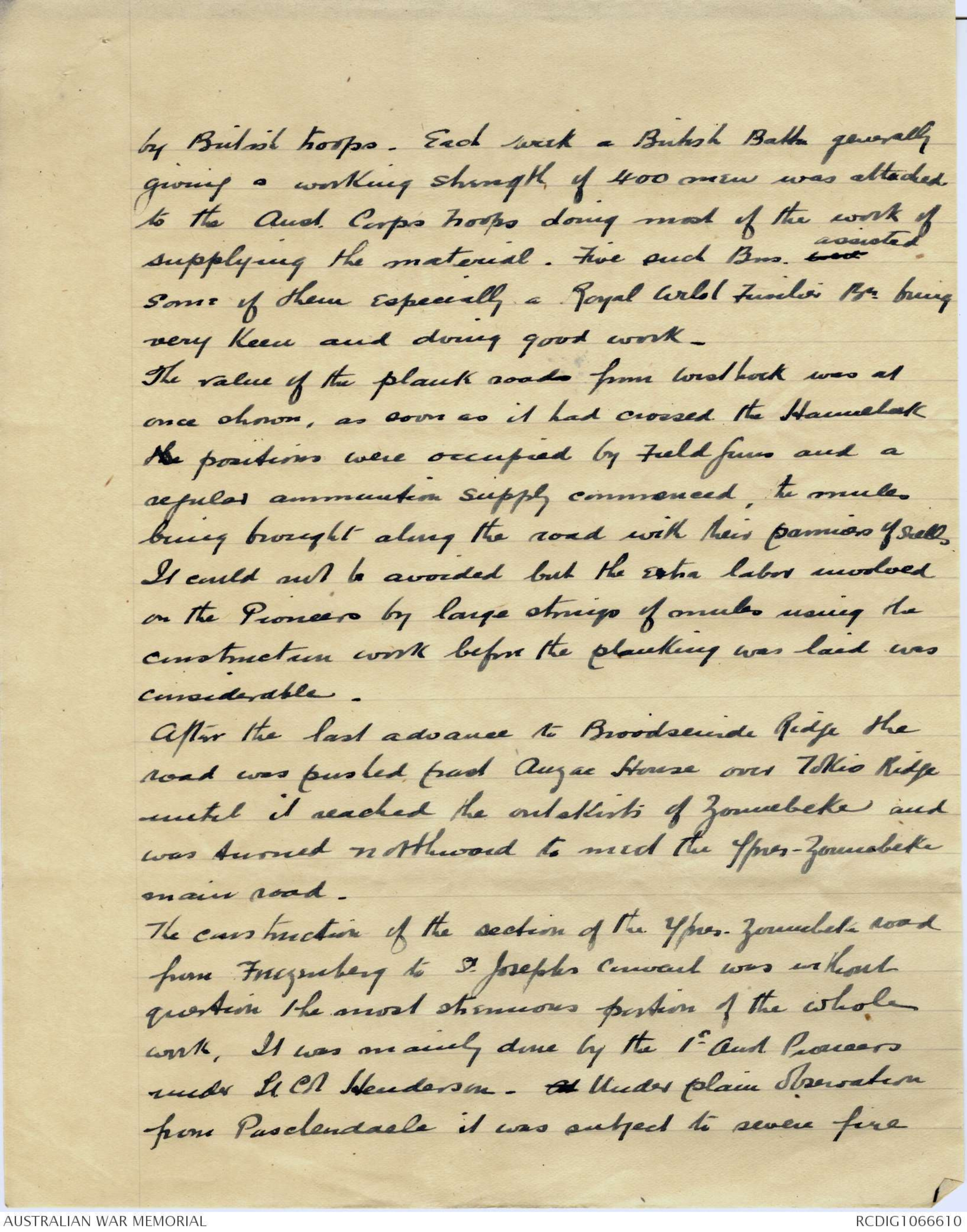
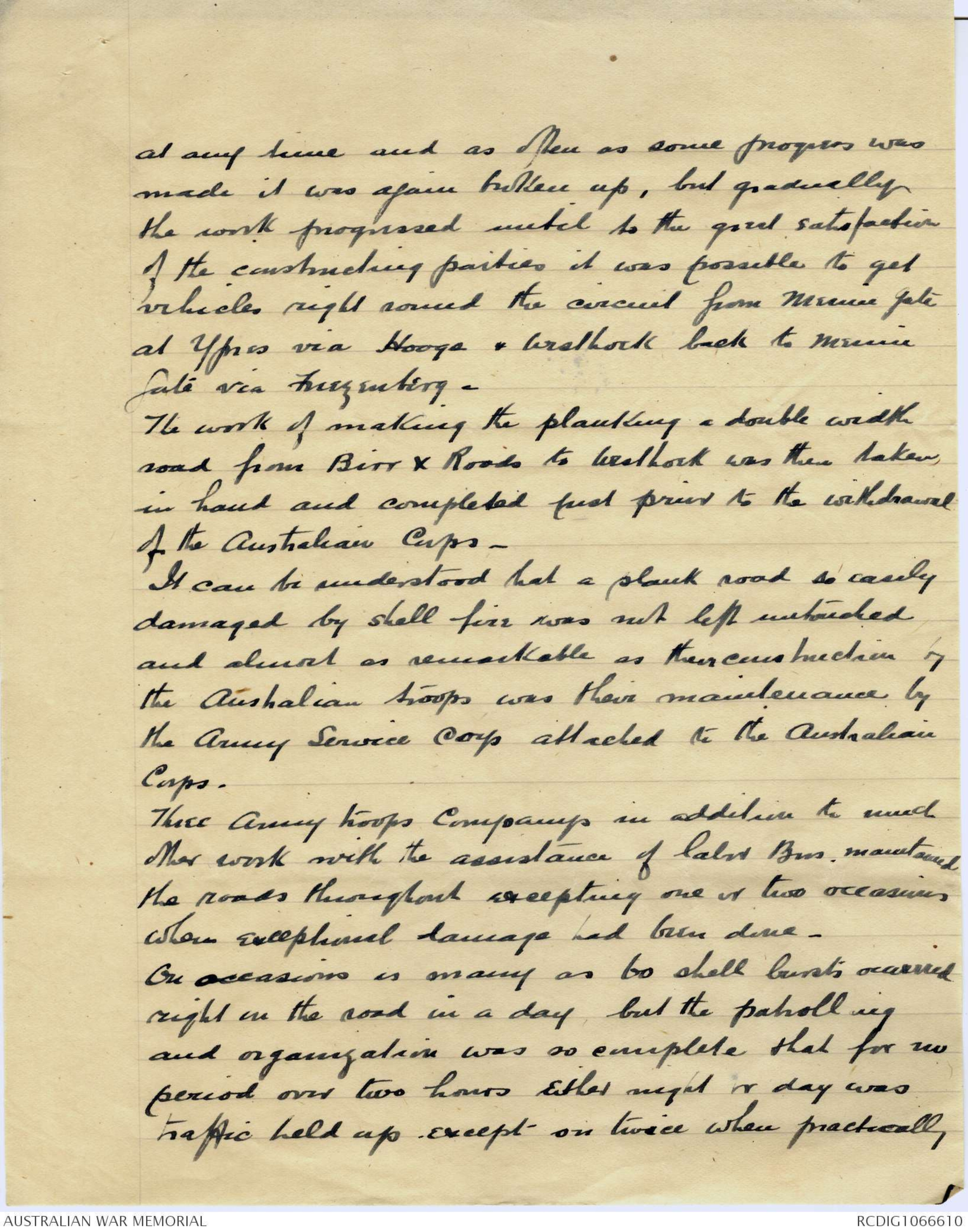
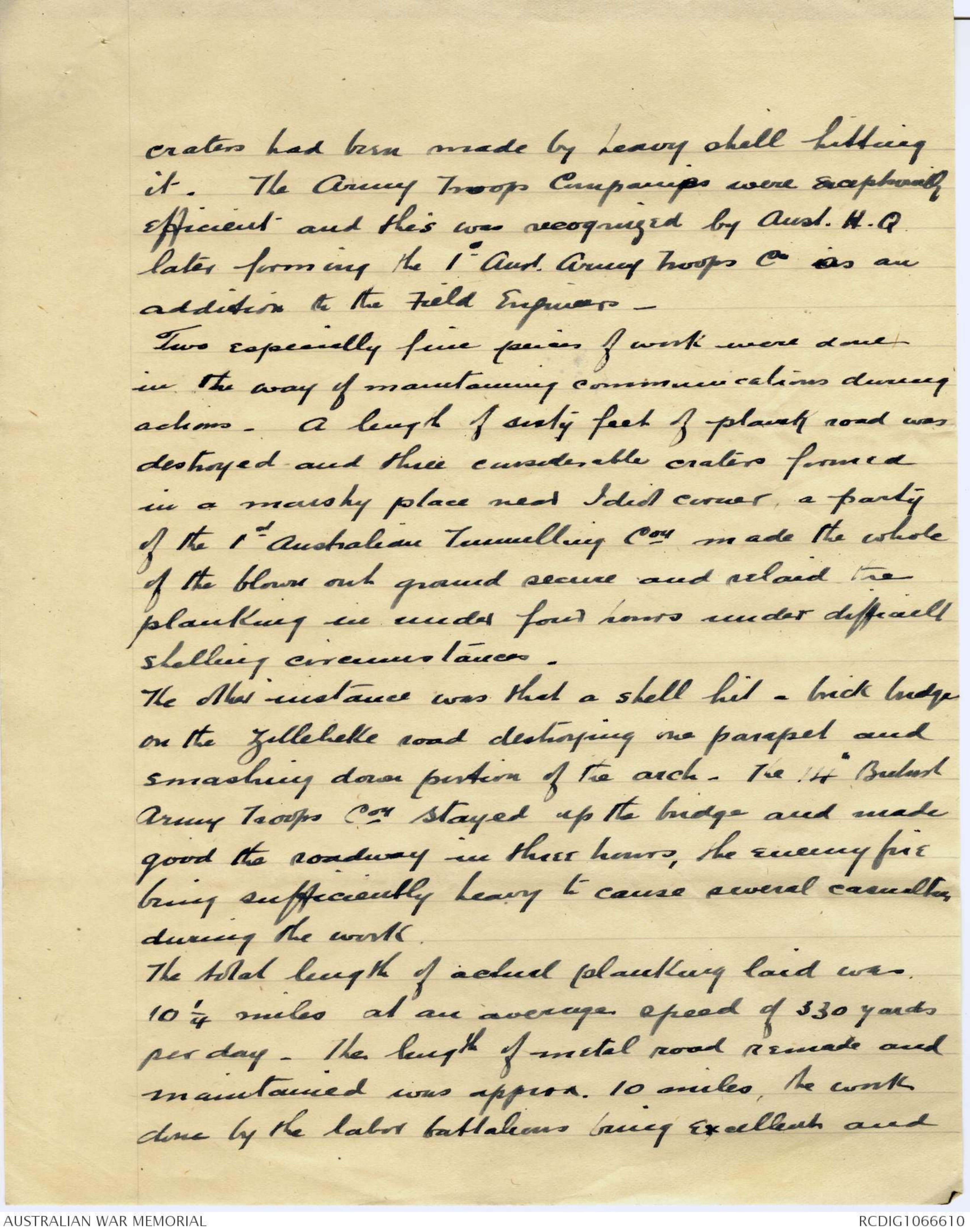
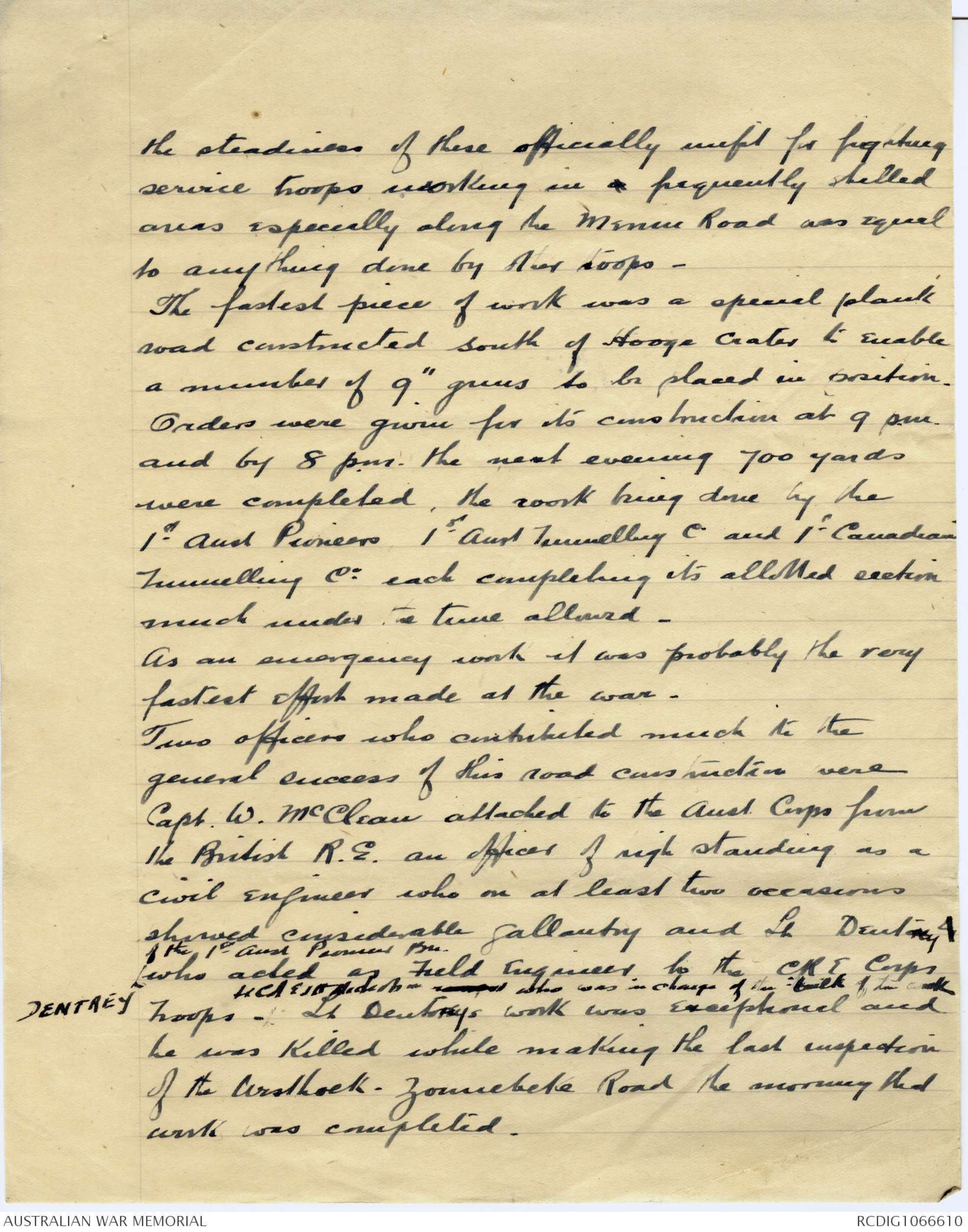
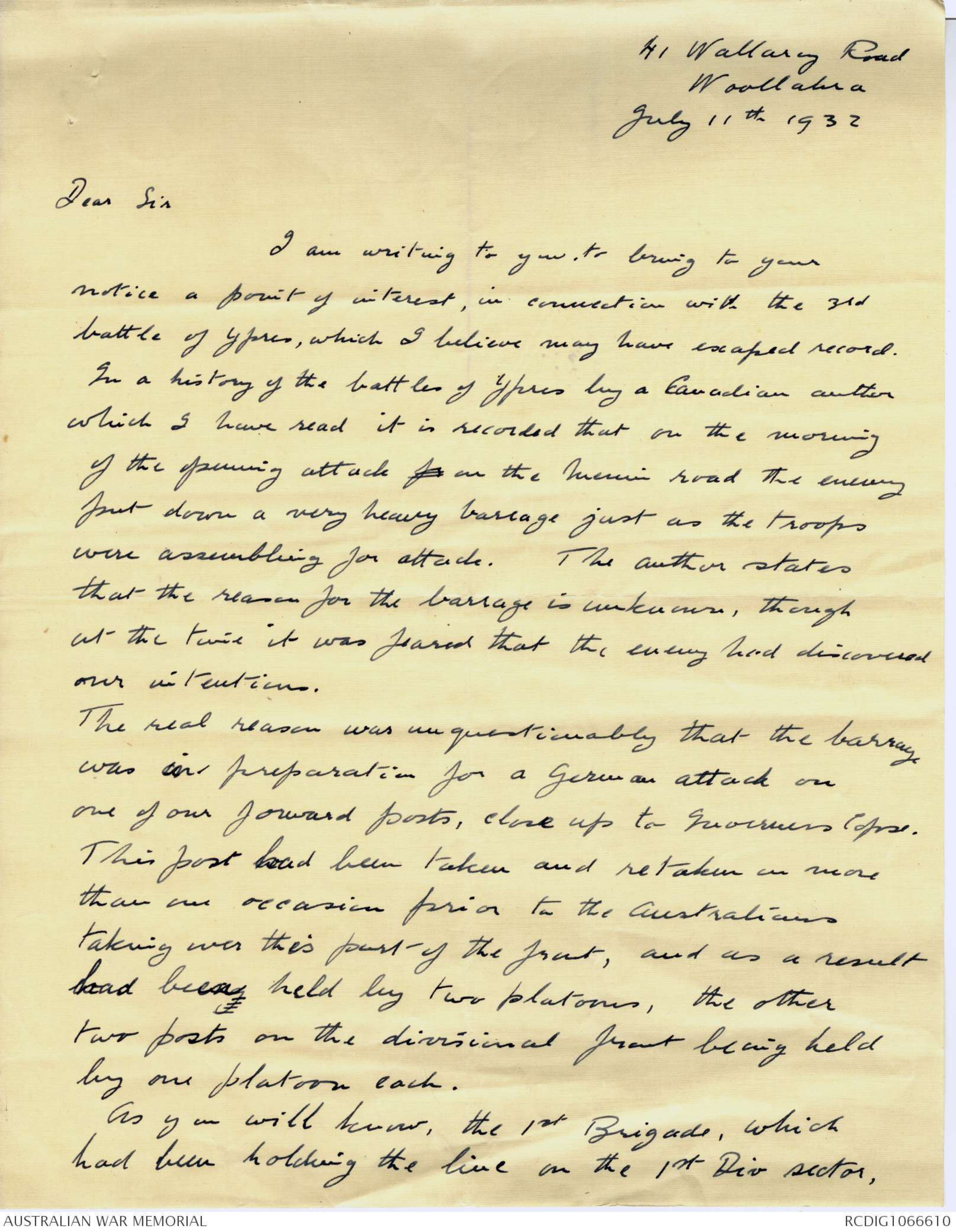
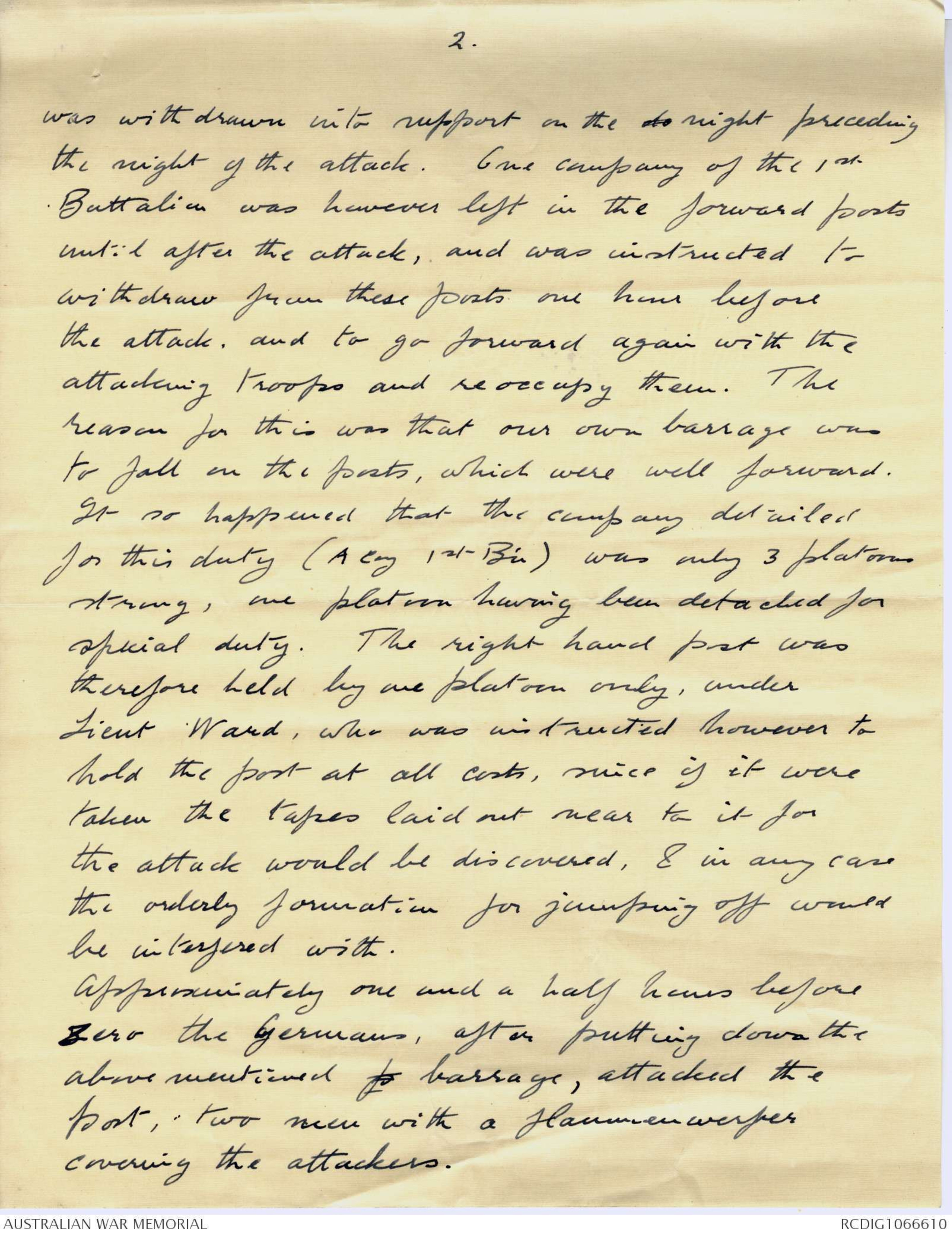
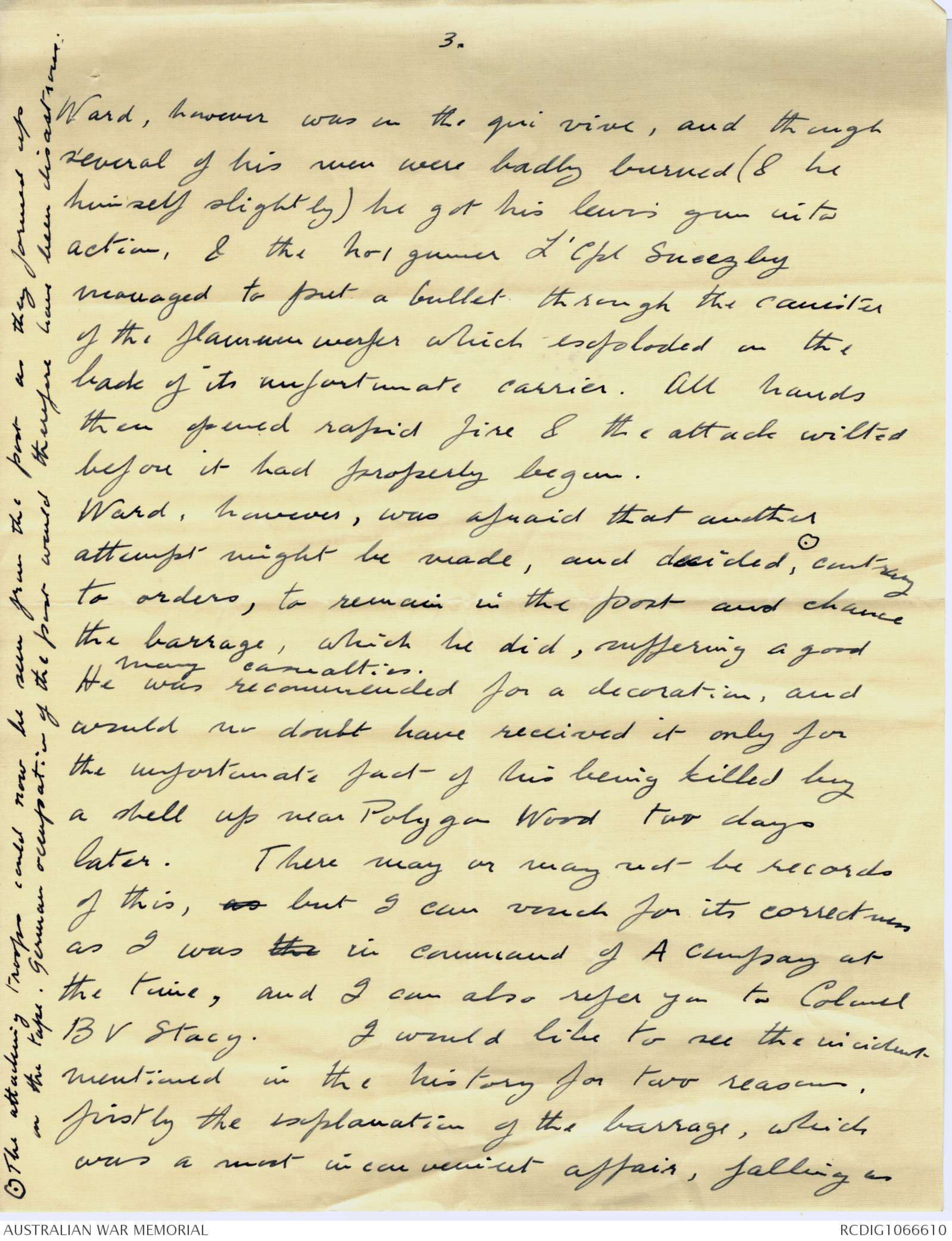
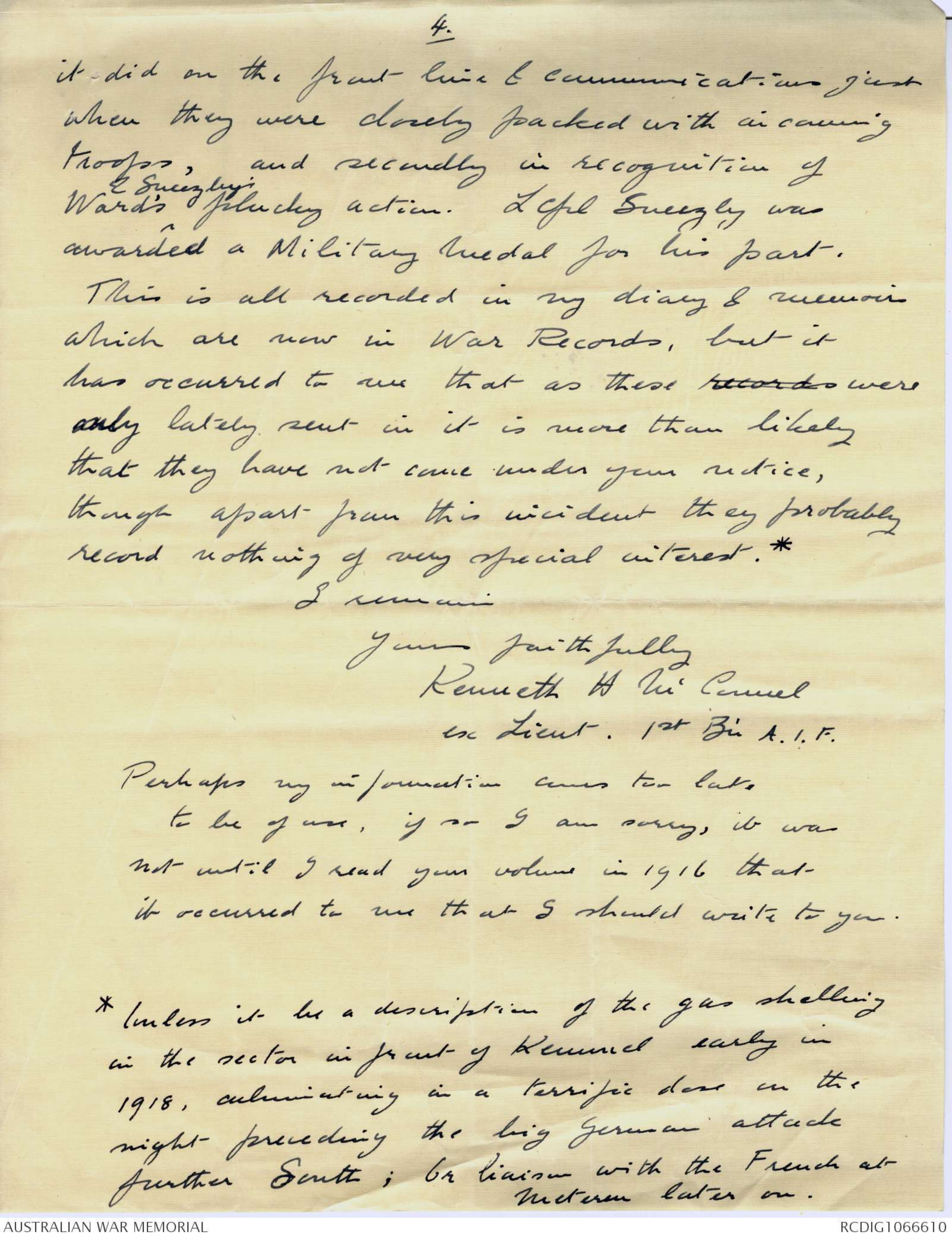
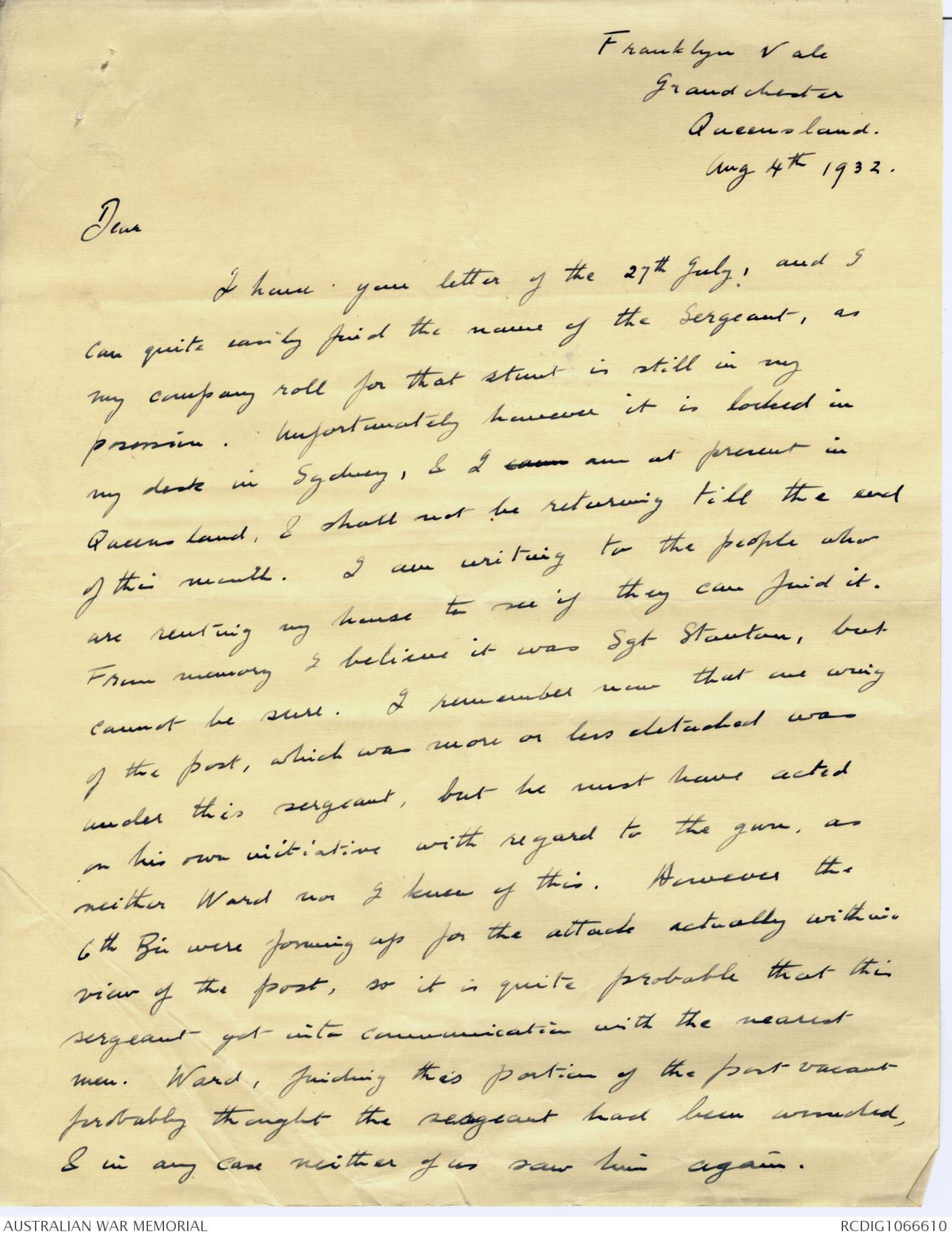
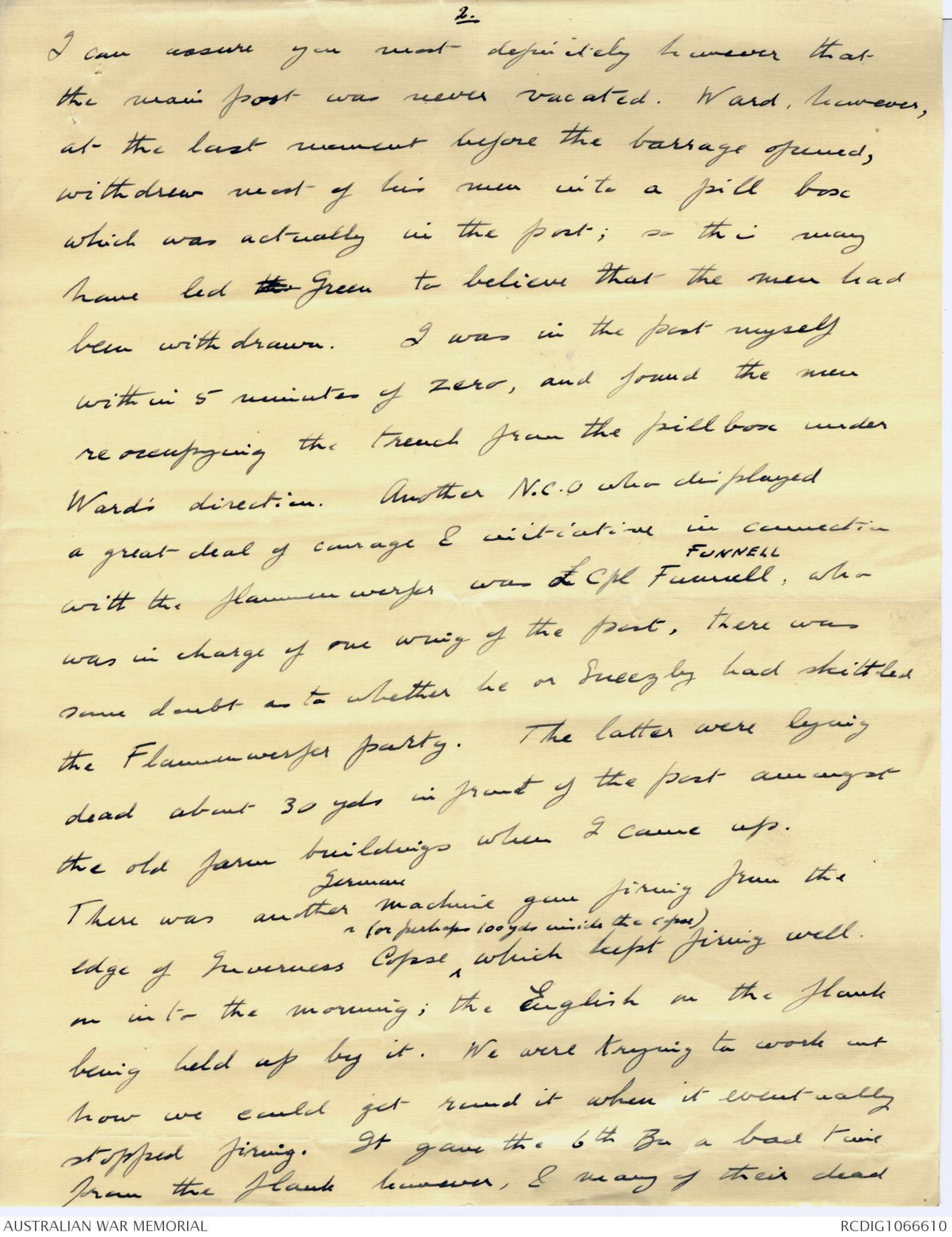
by British troops. Each week a British Battn generally
giving a working strength of 400 men was attached
to the Aust. Corps troops doing most of the work of
supplying the material. Five such Bns. were assisted
some of them especially a Royal Welsh Fusilers Bn bring
very keen and doing good work.
The value of the plank roads from Westhoek was at
once shown, as soon as it had crossed the [[Hauvellak?]]
the positions were occupied by Field Guns and a
regular ammunition supply commenced, the mules
being brought along the road with their panniers of shells.
If could not be avoided but the extra labor involved
on the Pioneers by large strings of mules using the
construction work before the planking was laid was
considerable.
After the last advance to Broodseinde Ridge the
road was pushed past Anzac House over Tokio Ridge
until it reached the outskirts of Zonnebeke and
was turned northward to meet the Ypres-Zonnebeke
main road.
The construction of the section of the Ypres-Zonnebeke road
from Frezenberg to St. Josephs Convent was without
question the most strenuous portion of the whole
work. It was mainly done by the 1st Aust. Pioneers
under Lt. Col Henderson. At Under plain observation
from Paschendaele it was subject to severe fire
at any time and as often as some progress was
made it was again broken up, but gradually
the work progressed until to the good satisfaction
of the constructing parties it was possible to get
vehicles right round the circuit from Menin gate
at Ypres via Hooge & Westhoek back to Menin
Gate via Frezenberg.
The work of making the planking a double width
road from Birr x Roads to Westhoek was then taken,
in hand and completed first prior to the withdrawal
of the Australian Corps.
It can be understood that a plank road so easily
damaged by shell fire was not left untouched
and almost as remarkable as their construction by
The Australian troops was their maintenance by
the Army Service Corp attached to the Australian
Corps.
Three Army troops Companys in addition to much
other work with the assistance of labor Bns. maintained
the roads throughout excepting one or two occasions
when exceptional damage had been done.
On occasions as many as 60 shell bursts occurred
right in the road in a day but the patrolling
and organization was so complete that for no
period over two hours either night or day was
traffic held up except on twice when practically
craters had been made by heavy shell hitting
it. The Army Troops Companies were exceptionally
efficient and this was reorganized by Aust. H.Q.
later forming the 1st Aust. Army Troops Co is an
addition to the Field Engineers.
Two especially fine pieces of work were done
in the way of maintaining communications during
actions. A length of sixty feet of plank road was
destroyed and three considerable craters formed
in a marshy place near Idiot Corner, a party
of the 1st Australian Tunnelling Coy made the whole
of the blown out ground secure and relaid the
planking in under four hours under difficult
shelling circumstances .
The other instance was that a shell hit a brick bridge
on the Zellebeke road destroying one parapet and
smashing down portion of the arch. The 14th British
Army Troops Coy stayed up the bridge and made
good the roadway in three hours, the enemy fire
bring sufficiently heavy to cause several casualties
during the work.
The total length of actual planking laid was
10¼ miles at an average speed of 330 yards
per day. The length of metal road remade and
maintained was approx. 10 miles, the work
done by the labor battalions being excellent and
the steadiness of these officially useful for fighting
service troops working in a frequently shelled
areas especially along the Menin Road was equal
to anything done by other troops.
The fastest piece of work was a special plank
road constructed south of Hooge Crater to enable
a number of 9" guns to be placed in position.
Orders were given for its construction at 9 p.m.
and by 8 p.m. the next evening 700 yards
were completed, the work being done by the
1st Aust Pioneers 1st Aust Tunnelling Co and 1st Canadian
Tunnelling Co each completing its allotted section
much under the time allowed.
As an emergency work it was probably the very
fastest effort made at the war.
Two officers who contributed much to the
general success of this road construction were
Capt. W. McClean attached to the Aust Corps from
the British R.E. an officer of high standing as a
civil engineer who on at least two occasions
showed considerable gallantry and Lt. Dentrey
of the 1st Aust. Pioneer Bn.
DENTREY who acted as Field Engineer to the CRE Corps
Troops. McLean made from xxxxxx who was in charge of the bulk of the work. Lt. Dentrys work was exceptional and
he was killed while making the last inspection
of the Westhoek - Zonnebeke Road the morning that
work was completed.
41 Wallary Road
Woollahra
July 11th 1932
Dear Sir,
I am writing to you to bring to your
notice a point of interest, in connection with the 3rd
battle of Ypres, which I believe may have escaped record.
In a history of the battles of Ypres by a Canadian author
which I have read it is recorded that on the morning
of the opening attack fr on the Menin road the enemy
put down a very heavy barrage just as the troops
were assembling for attack. The author states
that the reason for the barrage is unknown, though
at the time it was feared that the enemy had discovered
our intentions.
The real reason was unquestionably that the barrage
was in preparation for a German attack on
one of our forward posts, close up to Inverness Copse.
This post had been taken and retaken on more
than one occasion prior to the Australians
taking over this part of the front, and as a result
had been held by two platoons, the other
two posts on the divisional front being held
by one platoon each.
As you will know, the 1st Brigade, which
had been holding the line on the 1st division sector,
2.
was withdrawn into support on the lo night preceding
the night of the attack. One company of the 1st
Battalion was however left in the forward posts
until after the attack, and was instructed to
withdraw from these posts one hour before
the attack, and to go forward again with the
attacking troops and reoccupy them. The
reason for this was that our own barrage was
to fall on the posts, which were well forward.
It so happened that the company detailed
for this duty (A Coy 1st Bn) was only 3 platoons
strong, one platoon having been detached for
special duty. The right hand post was
therefore held by one platoon only, under
Lieut Ward, who was instructed however to
hold the post at all costs, since if it were
taken the tapes laid out near to it for
the attack would be discovered, & in any case
the orderly formation for jumping off would
be interfered with.
Approximately one and a half hours before
zero the Germans, after putting down the
above mentioned fi barrage, attacked the
post, two men with a Flammenwerfer
covering the attackers.
3.
Ward, however was in the qui vive, and though
several of his men were badly burned (& he
himself slightly) he got his lewis gun into
action, & the No 1 gunner L'Cpl Sneezby
managed to put a bullet through the canister
of the Flammenwerfer which exploded on the
back of its unfortunate carrier. All hands
then opened rapid fire & the attack wilted
before it had properly begun.
Ward, however, was afraid that another
attempt might be made, and decided, ©contrary
to orders, to remain in the post and chance
the barrage, which he did, suffering a good
many casualties.
He was recommended for a decoration, and
would no doubt have received it only for
the unfortunate fact of his being killed by
a shell up near Polygon Wood two days
later. There may or may not be records
of this, as but I can vouch for its correctness
as I was the in command of A Company at
the time, and I can also refer you to Colonel
B V Stacy. I would like to see the incident
mentioned in the history for two reasons,
firstly the explanation of the barrage, which
was most inconvenient affair, falling as
[*©The attacking troops could now be seen from the post as they formed up
on the tape. German occupation of the post would therefore have been disastrous.*]
4.
it did on the front line & communications just
when they were closely packed with incoming
troops, and secondly in recognition of
Ward's ^& Sneezby's planking action. L Cpl Sneezby was
awarded a Military Medal for his part.
This is all recorded in my diary & memoir
which are now in War Records, but it
has occurred to me that as these records were
only lately sent in it is more than likely
that they have not come under your notice,
though apart from this incident they probably
record nothing of very special interest. *
I remain
Yours faithfully,
Kenneth H McConnel
ex Lieut. 1st B'n A.I.F.
Perhaps my information comes too late
to be of use, if so I am sorry, it was
not until I read your volume in 1916 that
it occurred to me that I should write to you.
*Unless it be a description of the gas shelling
in the sector in front of Kemmel early in
1918, culminating in a terrific dose in the
night preceding the big German attack
further South; bn liaison with the French at
Meteren later on.
Franklyn Vale
Grandchester
Queensland.
Aug 4th 1932
Dear
I have your letter of the 27th July, and I
can quite easily find the name of the Sergeant, as
my company roll for that stunt is still in my
possession. Unfortunately however it is locked in
my desk in Sydney, & I cann am at present in
Queensland, & shall not be returning till the end
of this month. I am writing to the people who
are renting my house to see if they can find it.
From memory I believe it was Sgt Stanton, but
cannot be sure. I remember now that our wiring
of the post, which was more or less detached was
under this sergeant, but he must have acted
on his own initiative with regard to the gun, as
neither Ward nor I knew of this. However the
6th Bn were forming up for the attack actually within
view of the post, so it is quite probable that this
sergeant got into communication with the nearest
men. Ward, finding this portion of the post vacant
probably thought the Sergeant had been wounded,
& in any case neither of us saw him again.
2.
I can assure you most definitely however that
the main post was never vacated. Ward, however,
at the last moment before the barrage opened,
withdrew most of his men into a pill box
which was actually in the post; so this may
have led the Green to believe that the men had
been withdrawn. I was in the post myself
within 5 minutes of zero, and found the men
reoccupying the trench from the pill box under
Ward's direction. Another N.C.O. who displayed
a great deal of courage & initiative in connection
with the Flammenwerfer was L Cpl Furnell FURNELL, who
was in charge of one wing of the post, there was
some doubt as to whether he or Sneezby had skittled
the Flammenwerfer party. The latter were lying
dead about 30 yds in front of the post amongst
the old farm buildings when I came up.
There was another ^German machine gun firing from the
edge of Inverness Copse ^(or perhaps 100 yds inside the Copse) which kept firing well
on into the morning; the English on the flank
being held up by it. We were trying to work out
how we could get round it when it eventually
stopped firing. It gave the 6th Bn a bad time
from the flank however, & many of their dead
 Sandy Mudie
Sandy MudieThis transcription item is now locked to you for editing. To release the lock either Save your changes or Cancel.
This lock will be automatically released after 60 minutes of inactivity.